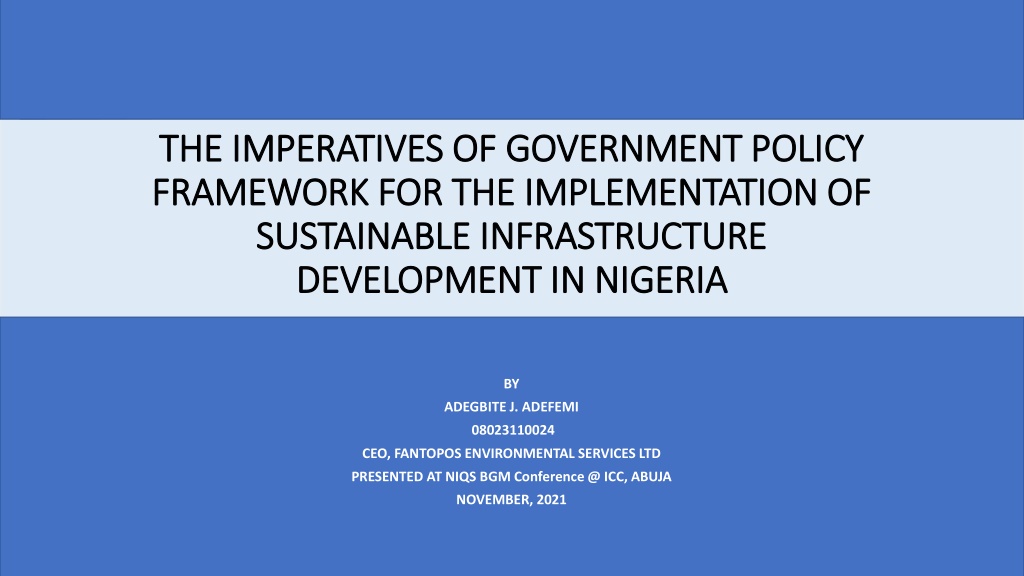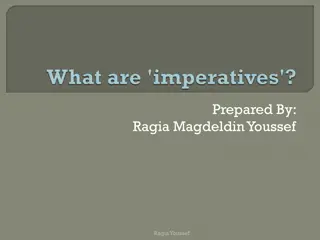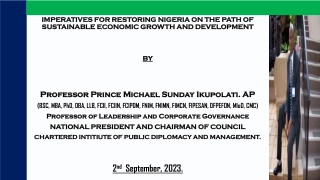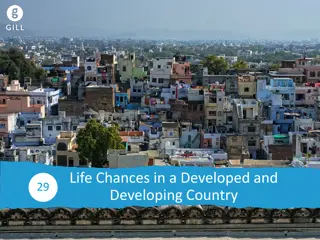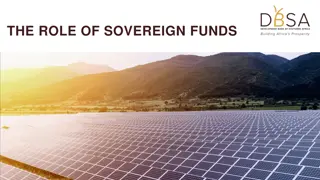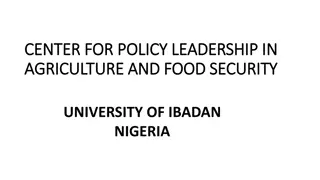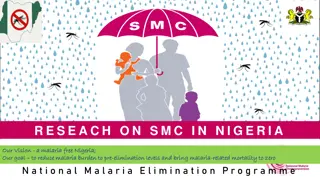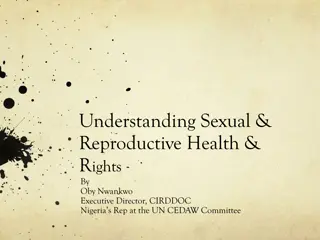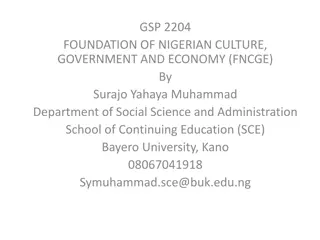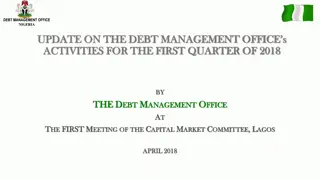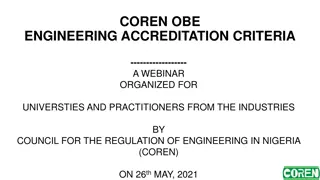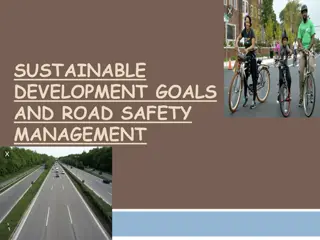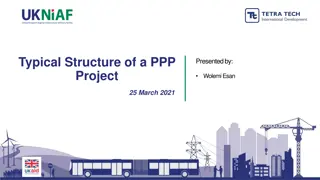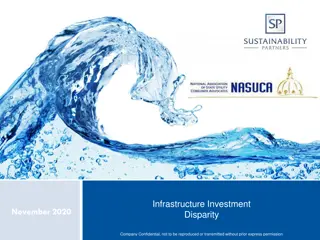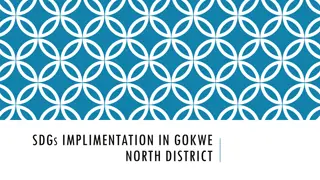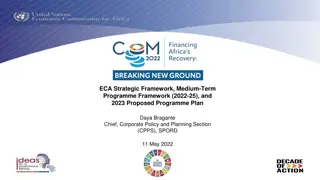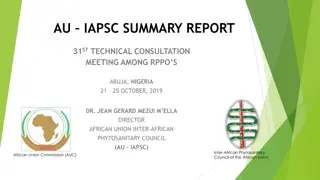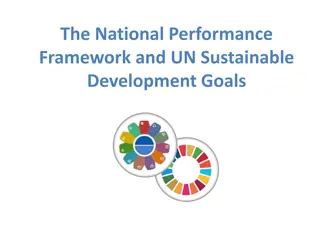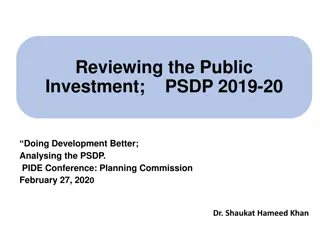Sustainable Infrastructure Development Framework in Nigeria: Imperatives and Implementation
Nigeria faces the imperative to revamp its infrastructure amidst economic growth. Private sector financing solutions are stepping in due to fiscal constraints. Sustainable infrastructures focus on holistic development to accelerate economic growth, alleviate poverty, and meet essential service needs while being environmentally friendly. Key infrastructure areas in Nigeria include waste governance, land-use planning, energy, and transportation management.
- Sustainable infrastructure
- Nigeria
- Development framework
- Sustainable development
- Infrastructure management
Download Presentation

Please find below an Image/Link to download the presentation.
The content on the website is provided AS IS for your information and personal use only. It may not be sold, licensed, or shared on other websites without obtaining consent from the author. Download presentation by click this link. If you encounter any issues during the download, it is possible that the publisher has removed the file from their server.
E N D
Presentation Transcript
THE IMPERATIVES OF GOVERNMENT POLICY THE IMPERATIVES OF GOVERNMENT POLICY FRAMEWORK FOR THE IMPLEMENTATION OF FRAMEWORK FOR THE IMPLEMENTATION OF SUSTAINABLE INFRASTRUCTURE SUSTAINABLE INFRASTRUCTURE DEVELOPMENT IN NIGERIA DEVELOPMENT IN NIGERIA BY ADEGBITE J. ADEFEMI 08023110024 CEO, FANTOPOS ENVIRONMENTAL SERVICES LTD PRESENTED AT NIQS BGM Conference @ ICC, ABUJA NOVEMBER, 2021
OUTLINE Background Sustainable Infrastructures Key Attributes Key Infrastructure Areas Why Sustainable Infrastructures? Key Government Policies to Implement Sustainable Infrastructure (S.I.) in Nigeria Ministries Department & Agencies in Charge of S.I. in Nigeria Challenges
BACKGROUND Nigeria is increasingly prosperous, coupled with its growing population and economy, the necessity to revamp Nigeria s infrastructure is at a crucial juncture. Traditionally, the federal, state, and local governments have financed critical projects, such as building roads, bridges, and ports, etc. As economic pressures such as swings in the exchange rate, fluctuations in oil prices, and liquidity limitations deplete fiscal budgets, the private sector has stepped in to create financing solutions to provide the necessary capital required to modernize and develop the country s infrastructure.
Sustainable Infrastructures Key Attributes Sustainable Infrastructures are meant to approach development from a holistic viewpoint that is based on domestic and global sustainable development goals, durability and having regard to social, financial, economic, environmental and political issues, public health and the well being of the citizenry. Holistic The Sustainable Infrastructures are meant to hasten economic growth and alleviate poverty, and to integrate the economy with other economies of the world. Integration The equipment and systems are designed to meet the population s essential service needs. Functional
Sustainable Infrastructures Key Attributes (contd.) These investments are crucial not only to renew old equipment in developed countries and bring them in sync with the fight against climate change, but also to bolster green economic growth in emerging markets and developing countries. Economic Growth These investments must be environmentally friendly, economic, social and institutionally sustainable. Sustainable
Key Infrastructure Areas in Nigeria WASTE GOVERNANCE LAND-USE PLANNING ENERGY TRANSPORTATION MANAGEMENT In Nigeria the processes involved in the management of waste are, storage, collection, transportation and disposal at dumpsites. Nigeria is a federal republic, with executive power exercised by the president. The other arms of government are the Legislature and Judiciary The Nigerian Land Use Act 1978 is the principal legislation that regulates contemporary land tenure in Nigeria., which vests in the Governor, ownership of the land in the State Coal, petroleum reserves, natural gas, hydroelectricity, solar and wind are major energy resources in Nigeria. Roads, Railways, Waterways, Pipelines, Ports, Harbors and Airports are important transportation Infrastructure in Nigeria.
Why Sustainable Infrastructures? 70% of global green house gas emissions came from carbon-intensive infrastructures. 1 70% 70% Reduction in air pollution: coal-fired power station increases air pollution compared to usage of renewable sources of energy. 2 3 Better Health outcomes 4 Efficient cities with good health, education and growth 5 To prevent crises the world may face due to a high carbon pathway.
Key Government Policies to Implement Sustainable Infrastructure in Nigeria FINANCE & PUBLIC-PRIVATE PARTNERSHIP 5 LOCAL CONTENT POLICY 1 6 2 TRANSPORTATION TECHNOLOGY 7 3 ENERGY BUILDINGS & CONSTRUCTION 8 SOLID WASTE MANAGEMENT 4 RESEARCH AND DEVELOPMENT
Key Government Policies to Implement Sustainable Infrastructure in Nigeria Local Content in Sustainable Infrastructure Development AN ACT TO PROVIDE FOR THE DEVELOPMENT OF NIGERIAN CONTENT IN THE NIGERIAN OIL AND GAS INDUSTRY, NIGERIAN CONTENT PLAN, SUPERVISION, COORDINATION, MONITORING AND IMPLEMENTATION OF NIGERIAN CONTENT; AND FOR RELATED MATTERS.- Act 2010. This involves increasing the input of local labour, goods and services ( local content ) in the delivery of infrastructure projects. 1 NCDMB (Nigeria Content Development Monitoring Board) was established primarily to drive the development of Nigerian content in the Nigerian oil and gas industry by prescribing minimum thresholds for the use of local services and materials for the promotion of technology and skill to the Nigerian labour in the oil and gas industry. Benefits - Economic Growth - Job Creation for locals. - Development of Human resources and skill. - Technological advancement.
Key Government Policies to Implement Sustainable Infrastructure in Nigeria Local Content in Sustainable Infrastructure Development 1 Actions that should be taken to deliver a local content policy within the context of the infrastructure sector are as below: Initial Planning consulting with local users and affected communities developing an operation and maintenance strategy for each new project evaluating alternative solutions and designs for the opportunities presented to build local capacity Infrastructure Design Contract Strategy & Execution consultants and contractors who promote local content through design and specification should be prioritized and given consideration. where procurement of materials, components are not done locally, policy should provide ways to subsequently produce such locally. Detailed designs should, where appropriate, specify technologies and methods of work that are within the capability of local contractors. Standardising designs allows local contractors to build skills and increase their efficiency, specifying locally produced materials, components and equipment.
Key Government Policies to Implement Sustainable Infrastructure in Nigeria Technology in Sustainable Infrastructure Development These are policies that encourage investment and the use of new and emerging technologies to reshape the dynamics of infrastructure development with a renewed focus on sustainable development. Such technologies offer various benefits to all stakeholders, including users, the authority/government, concessionaires and developers. 2 These technologies include: Improved Materials use of recycled materials, plastic wastes, self-healing asphalt, LED light technology, solar power & self-sufficient, and LEED buildings and construction methods Use of automation and machine-control technologies, to improve the quality of infrastructure. Key digital technologies such as IoT, AI, machine learning, and blockchain, amongst others, will have vast implications in infrastructure, both positive through efficiency gains and new business models technologies in infrastructure development and management, such as project monitoring information systems, intelligent transport management systems and advanced traffic management systems, carbon capture and storage technologies. Such Policies should; - Identify key technologies with the potential to shape the infrastructure of the future - drawing from case studies of existing example. - provide policy guidance on how to foster tech innovation that encourages long-term investment, and alignment with sustainability and quality initiatives
Key Government Policies to Implement Sustainable Infrastructure in Nigeria Energy in Sustainable Infrastructure Development 3 Moving forward, investments need to be shifted to low-carbon, climate-resilient energy infrastructure and scaled-up significantly to support the broader development, economic, energy security and climate agendas. PUBLIC GOVERNANCE POLICY AND ENERGY MARKET INSTITUTIONS: improving the governance and regulatory quality of electricity markets, mapping of geographical distribution of renewable energy resources, and coordinating deployment of the electricity grid with that of clean energy generation; Some Key issues for policy makers are: INVESTMENT POLICY: applying investment policy principles such as nondiscriminatory treatment of international investment in clean energy, intellectual property protection, transparency and contract enforcement; INVESTMENT PROMOTION AND FACILITATION: improving coherence of the broad system of investment incentives and disincentives, with the objective of shifting incentives away from conventional energy towards clean energy. ENERGY MARKET DESIGN/COMPETITION POLICY: allowing multiple actors to engage in electricity generation as well as transmission/distribution by designing open and transparent procurement processes for renewable energy projects
Energy in Sustainable Infrastructure Development (contd.) The few laws briefly discussed below provide a legal framework for renewable energy in Nigeria Electricity Power Sector Reform (EPSRA) Act 2005- the Act is the principal law that governs the Nigeria power sector. The Act is established to provide for the formation of companies to take over the function, assets and liabilities, and staff of the National Electric Power Authority and to develop a competitive electricity market. NERC Mini-Grid Regulation 2016- the regulation applies to all mini-grids with a generation capacity of up to 1MW, the owners, operators, and users of the mini-grids as well as other private or public stakeholders. Mini-grid means electricity supply system with its power generation capacity, supply electricity to more than one customer which can operate in isolation from or be connected to a distribution licensee's network. While a mini-grid developer is an entity established which has applied for the registration or a permit to operate an isolated mini-grid or which is preparing a tripartite contract for an interconnected mini-grid. NERC Renewable Energy Feed-In Tariff Regulations 2015- NERC has also established a feed-in tariff for renewable energy-based power generation which is aimed at promoting the investment of renewable energy in Nigeria. The tariff estimates that Nigeria will generate at least 1000MW from renewable energy.
Legal framework on renewable energy (contd.) National Electric Power Policy 2001- the policy lays out the framework for the reform and liberalization of the Nigerian Electricity Supply Industry (NESI). The goal of the policy is to ensure that the electricity supply industry meets the electricity demand efficiently and economically in Nigeria. Renewable Electricity Policy Guidelines 2006- this policy was issued by the Federal Ministry of Power for the provision of adequate and reliable power supply in Nigeria. The policy is aimed at influencing the generation, transmission, and distribution projects in the power sector, provide direction, and also facilitating the emergence of a private sector towards a competitive and efficient electric power industry. National Renewable Energy and Energy Efficiency Policy 2015- the NREEEP is a policy document approved by the Federal Executive Council (FEC). The purpose of the policy is to set out a framework for action to address Nigerians challenge pf inclusive assess to modern and clean energy resources, improved energy security and climate objective, also to recognize the significance of renewable electricity generation activities by providing for the development, operation and maintenance, and upgrading of new and existing renewable electricity generation activities.
Framework on renewable energy contd. Environmental Impact Assessment Act Cap E2, LFN 2004- the Act makes it mandatory for environmental impact assessment to be conducted for projects likely to have significant effects on the environment, which also includes power projects. a power developer who intends to carry out power generation operations through the use of renewable energy must register the project with the Federal Ministry of Environment for an environmental impact assessment as Section 2 of the Act provides for the assessment of public or private projects likely to have a significant impact on the environment. Nigerian electricity Management Services Agency (NEMSA) Act 6 of 2015- the NEMSA Act is responsible for the enforcement of technical electrical standards and regulations as prescribed by NERC, including technical inspection, the testing, and certification of electrical installations, electricity meters, and instruments to ensure the efficient production and delivery of safe, reliable and sustainable electric power supply and the guarantee of the safety of lives and property in the Nigerian electricity supply industry. The Act establishes the National electricity Management Services Agency (NEMSA) as the agency to carry out these functions.
Key Government Policies to Implement Sustainable Infrastructure in Nigeria Research and Development in Sustainable Infrastructure Development The implementation of new technologies and methodologies would require dedicated research and development by both the government and private sector. 4 Key Policies include: INVESTMENT IN R&D: should be facilitated by the government and private sector for sustainable infrastructure development. INVESTMENT IN EDUCATION SECTOR: education to speed the transformation from a resource- to a knowledge-based society; RESEARCH POLICY: a long-term research planning for a sustainable future for sustainable development, including foresight to identify needs, research-led social shaping of concepts and knowledge brokering Benefits - R&D helps drive technology and innovation, e.g. improved materials in road construction such as recycled materials, plastic wastes, self-healing asphalt, etc. - International Energy Agency figures indicate that technologies and best practices could save between 18 and 26% of current primary energy use in global industry.
Key Government Policies to Implement Sustainable Infrastructure in Nigeria Finance & Public-Private Partnership in Sustainable Infrastructure Development 5 Mobilization of finance for sustainable infrastructure has been a key policy objective of governments as a way to sustain economic growth and to reach development objectives. Some policy guidelines are: FINANCIAL MARKET POLICY: strengthen domestic financial markets and instruments, and facilitate access to international capital markets and long-term finance; Development of guidelines for promoting private sector and capital markets participation in sustainable economic growth. The just released guideline on the 100 for 100 PPP- Policy for Production and Productivity by CBN. INFRASTRUCTURE FINANCE POLICY: gathering statistics on investment levels, institutional investor preferences, and researching financial instruments (like equity, funds, project bonds, etc.), and risk mitigation instruments, helping to better describe sustainable infrastructure as an asset class.
Key Government Policies to Implement Sustainable Infrastructure in Nigeria Transportation in Sustainable Infrastructure Development 6 Sustainable transportation can enhance economic growth and improve accessibility. Sustainable transport achieves better integration of the economy while respecting the environment. Some policy guidelines are: Green Transportation: the use of bicycles, electric bikes and vehicles, green trains for transportation as primary means of transportation. Bikeable Cities: design of bikeable cities and investment in cycling infrastructure to build culture of cycling and sustainable mobility. Mass Transit Systems: helps reduce a cities toxic emissions and greenhouse gases by lessening single-automobile usage. Mass transit has numerous ways to be more sustainable by including sustainable elements in operations, and preventing environmental damage, saving energy, and reducing the use of fossil fuels.
Key Government Policies to Implement Sustainable Infrastructure in Nigeria Buildings and Construction in Sustainable Infrastructure Development 7 A Green or LEED building, is a building that, in its design, construction or operation, reduces or eliminates negative impacts, and can create positive impacts, on our climate and natural environment. Some policy guidelines are: Audit & Certification Of Buildings: objective of building certification is to publicize the sustainability performance of buildings, thus enabling owners and tenants to take informed decisions. Building Codes: generally state requirements such as energy efficiency, indoor air quality, sustainable site selection, and materials in a building which should be enforced. Develop Policy Building Blocks, which will provide the policy makers with the information and methodologies necessary to design and employ the most suitable sustainable building policy tools adapted to the local context.
Key Government Policies to Implement Government Sustainable Infrastructures in Nigeria Solid Waste Management - in sustainable infrastructure Development 8 It entails a holistic approach which spans from reduction, sorting, reuse, collection, storage, transport, recovery, recycling, treatment and disposal in an environmentally sound manner. One of the benefits, apart from recovery of useful resources, creating employment and waste to energy, is reducing Green house gas (GHG) emissions to the environment and if managed properly would earn income and investments through instruments such as the Clean Development Mechanism (CDM) of Kyoto Protocol and other global funding mechanisms for GHG emissions reductions.
Framework on Solid Waste Management National Policy on Health Care Waste Mgt. (2013). National Policy on Solid Waste Waste Mgt. (2020) National Policy on Plastic Waste Mgt. (2020) and
Other Key Government Policies to Implement Sustainable Infrastructures in Nigeria across sectors Environmental Impact Assessment Act (Cap E12 LFN 2004). This law sets out the general principles, procedures and methods of EIA in various sectors. It is an instrument by which we identify and assess the potential environmental, social and health impacts of a proposed project, evaluate alternatives, and design appropriate environmental and social management plans during the life-cycle of the project. Infrastructure Concession Regulatory Commission Act 2005. It was established to superintend and regulate Public-Private Partnership (PPP) , aimed at addressing Nigeria s physical infrastructure deficit which hampers economic development.
Other Key Government Policies to Implement Sustainable Infrastructures in Nigeria across sector (Contd.) Nigeria Sustainable Banking Principles (NSBP) commenced in 2012, banking strategy aim in sustainable financing. Guidelines for the Implementation of the 100 for 100 Policy for Production and Productivity a financial instrument designed to create the flow of finance and investments to enterprises with potential to catalase sustainable economic growth. Aim is to reverse the nation s over reliance on imports Green Bonds Initiative the Nigeria Sovereign Green Bond is a financial mechanism to facilitate and assist Nigeria in meeting her Nationally Determined Contribution. The bonds are focused specifically on sustainability and are used to fund green projects. The bonds may be issued by corporations, government agencies and global organizations. The money raised through green bonds may be used for a variety of purposes. Nigeria issued green bonds worth N10.69 billion and N15 billion in 2017 and 2019 respectively for financing sustainable environmental projects.
Green Bond Initiative Contd. Projects handle: i. Afforestation ii. Transportation (Rail, Road, Aviation) iii. Water iv. Solid Waste Management v. Agriculture vi. Renewable Energy (Rural Electrification Programme)
Ministries Department and Agencies (MDAs) in Charge of Sustainable Infrastructures in Nigeria Nigerian Electricity Regulatory Commission (NERC) - NERC is primarily responsible for granting and issuing licenses and approvals for the electric value chain from generation, distribution, transmission, trading, system operations, metering, etc. Transmission Company of Nigeria- the TCN performs three major functions the market operator, system operator, and transmission service provider. TCN manages the electricity transmission network in Nigeria. It is one of the bodies established to issue licenses for the transmission of electricity. it is also responsible for the evacuation of electricity generated by the electricity generating companies and taking it to the distribution companies, Nigerian Bulk Electricity Trader- NBET is the sole holder of a bulk purchase and resale license in Nigeria. It enters into bulk Power Purchase Agreements (PPA) with power generation companies and independent power producers for the bulk purchase of electric power and services which is in turn resold to the Discos (distribution companies) in Nigeria under a vesting contract.
Other MDAs are Standards Organization of Nigeria- in support of the advancement of renewable energy, the SON in collaboration with the Nigerian Energy Support Programme (NESP). The SON is charged with the responsibility of setting the standards of all products and equipment in or imported into Nigeria. Concerning energy, the SON ensures that all electrical and electronic products in or imported into Nigeria conform to the quality and standards as set by the Organization. Nigerian Electricity Management Services (NEMSA)- this regulatory agency is responsible for enforcing the technical standards in the power sector in collaboration with the SON to ensure that all electrical materials conform with the required standard and quality and also conduct an inspection of all electricity projects in Nigeria. Federal Ministry of Environment- this is the principal authority regulating environmental matters in Nigeria. The Ministry is in charge of EIA for projects in Nigeria which include renewable energy projects and also issuing EIA certificates for approved projects. National Environmental Standards And Regulations Enforcement Agency (NESREA)- this regulatory agency is responsible for the protection and development of the environment, biodiversity conservation and sustainable development of Nigeria's natural resources, and also for environmental technology. The agency also issues permits to companies involved in new or used electrical electronic equipment manufacturing, processing, recycling, power generation, transmission, or distribution.
MDAs Contd. Federal Ministry of Transport Federal Ministry of Power, Federal Ministry of Works and Housing Federal Ministry of Science & Technology Federal Ministry of Industry Federal Ministry of Information Federal Ministry of Finance Federal Ministry of Budget and Planning Federal Ministry of Petroleum Central Bank of Nigeria Sustainable Development Goal Office
Challenges Lack of funds and annual appropriation of funds is inadequate, and the capital needed to co-finance the infrastructures is high Lack of private investment because of high capital involved in developing sustainable infrastructures Political instability resulting to abandoning of projects due to much reliance on government for subsidies and waivers. Bureaucracy Unstable currency and poor investment environments Lack of maintenance of the the infrastructures Inadequate economic transformation policies leading to increase in greenhouse gases resulting into severe drought, flooding, loss of bio- diversity and significant health impacts
Way Forward In Promoting Sustainable Infrastructures Sensitization Advocacy Promotion and encouraging Public-Private Partnership (PPP) Initiatives Government should promote and encourage the use of low-carbon infrastructure projects Mainstreaming of policies on Sustainable Infrastructure in Nigeria.
Conclusion Let Us Think Globally And Act Locally
